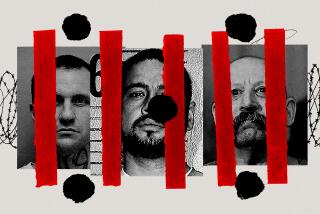Dahmer Slain in Prison Attack; Inmate Held
CHICAGO — Jeffrey L. Dahmer, who confessed to killing 17 men and boys in a cannibalistic, homoerotic murder spree that horrified the world, was beaten to death Monday in a prison bathroom.
Dahmer suffered massive head injuries--possibly inflicted with a broom handle--while he was on cleanup duty in the gymnasium at the Columbia Correctional Institute in Portage, Wis. He died at nearby Divine Savior Hospital, prison officials said.
Christopher J. Scarver, another prisoner who was in the bathroom at the time and whose clothes were splattered with blood, was being held in connection with Dahmer’s murder. A third inmate, identified by authorities as Jesse Anderson, was also attacked and was hospitalized with serious head injuries, Wisconsin Corrections Secretary Michael Sullivan said.
Sullivan declined to speculate on a motive. He said the suspect is a convicted murderer from Milwaukee who had no connection with any of Dahmer’s victims or their families.
He also said Dahmer, 34, who had been allowed to mix at times with the general prison population and was unsupervised at the time of the attack, was considered without “undue risk” and had never asked for special protection.
Dahmer had been attacked in prison at least once before. On July 3, an inmate tried to slash his throat with a razor blade attached to a homemade plastic handle during a chapel service. But the blade snapped off and Dahmer suffered only a scratch.
“It’s a sad ending to a very sad story,” said Milwaukee County Dist. Atty. E. Michael McCann, who had prosecuted Dahmer. “He’s inflicted so much pain on families and now, unfortunately, his family will feel the same thing.”
News of the slaying stunned the relatives of some of Dahmer’s victims.
“We do not rejoice in the news of the death of Jeffrey Dahmer,” said Shirley Hughes, whose 31-year-old son Anthony was among those killed at Dahmer’s hands. “This certainly does not bring back our son; our suffering continues . . . and forever in our souls will remain the mysteries surrounding the reasons for these senseless murders.”
But some of the other families, who are hoping to benefit from the sale of Dahmer’s personal belongings--clothing, furniture, video cameras, vats, needles, drills, hand saws and homosexual pornographic items--as partial payment for millions of dollars in judgments they have won against him, saw his death differently.
“Today the chickens came home to roost--there is over $100,000 worth of stuff, and now that he’s dead it won’t be needed as evidence,” said Thomas Jacobson, a Milwaukee lawyer representing eight of those families. “An auction for fanciers of the grotesque will bring in more.”
Dahmer, a former chocolate factory worker, was serving 16 consecutive life terms at the prison about 80 miles northwest of Milwaukee. He would not have been eligible for parole for 936 years.
Because Dahmer had confessed to the killings, the only issue at his 1992 trial was whether to accept his plea that he was criminally insane--hence not responsible for his actions--at the time of the murders.
Dr. Park Dietz, a Newport Beach, Calif., forensic psychiatrist hired by the state of Wisconsin to interview Dahmer, concluded that he was not criminally insane, as defined by Wisconsin law, and therefore was responsible.
In a prepared statement released Monday, Dietz said that he found Dahmer to be “more pleasant, polite, free of prejudice and gentle than people are prepared to accept.”
“He was genuinely remorseful for his crimes, correctly realizing he would not have killed had he not been drinking,” Dietz said. “And had a sincere desire to understand what brought him to such perverse sexual pursuits.”
Dahmer’s sentencing in Milwaukee County Circuit Court on Feb. 17, 1992, followed 12 days of macabre testimony describing how he lured victims from gay bars, shopping malls and other public places to his home. There, Dahmer drugged his victims’ drinks, then tortured and killed them, in many cases drilling holes in their heads, having sex with the bodies and in some cases cannibalizing them.
The killing spree began in 1978 with Steven Mark Hicks, an 18-year-old hitchhiker whom Dahmer befriended and brought back to his boyhood home in Bath Township, Ohio, for a few beers. Dahmer said he choked Hicks with a barbell, then smashed his corpse with a sledgehammer and scattered the bone fragments across his yard.
In an interview on NBC’s “Dateline” last March, Dahmer explained that “lust played a big part of it. Control and lust.”
“Once it happened the first time, it just seemed like it had control of my life from there on in,” he said. “The killing was just a means to an end. That was the least satisfactory part. I didn’t enjoy doing that. That’s why I tried to create living zombies with . . . acid and the--the drill.”
Dahmer’s reign of terror came to an end on July 22, 1991, when a handcuffed man escaped from his apartment and flagged down a police car. Officers were led back to Dahmer’s foul-smelling one-bedroom apartment, where they discovered painted skulls and severed heads--one of them in a refrigerator--a kettle containing body parts and torsos in a vat brimming with acid.
The next day Dahmer admitted to the slayings, telling police investigators that “I carried it too far, that’s for sure.”
Two months before the arrest, police officers had visited Dahmer’s home, summoned by two women who reported seeing him chasing a naked boy through the streets.
The officers who arrived at the scene believed Dahmer’s contention that the boy, a 14-year-old Laotian, was his 19-year-old drunken lover. They returned the youth, Konerak Sinthasomphone), to Dahmer’s apartment and then joked about having to head back to the station to get “deloused.”
Dahmer killed Sinthasomphone--a victim of a crude lobotomy attempt--shortly after the officers left.
Gerald Boyle, the defense lawyer who depicted Dahmer during the trial as a man possessed by a desire for sex with the dead, told reporters on Monday that a fatal prison attack was inevitable.
“Dahmer had a death wish, and I know that he didn’t have the gumption to do it himself,” Boyle said. “So I predicted that the day would come when he would be killed in prison.”
“He had a limited amount of access to people,” Dahmer’s stepmother, Shari Dahmer, told her hometown television station WJW in Cleveland on Monday. “But obviously, as happened in chapel, someone did get to him.”
“He never expressed fear,” she added. “From the day he was arrested he felt that he deserved anything that he got.”
But McCann said prison authorities should have realized Dahmer was in danger, particularly from inmates who considered him a racist killer; Dahmer was white, and most of his victims were African American or Asian.
“That’s not justice. This is murder,” McCann said. “I’m hoping that whoever did it doesn’t emerge as a folk hero.”
Sullivan, however, insisted that the prison is “as safe as any other institution in this country.”
“The taxpayers can’t afford 100% safety in the prisons . . . there is an understanding in prison that staff is far outnumbered by inmates and that means we cannot guarantee anyone’s absolute safety 24 hours a day seven days a week.”
Times researcher John Beckham in Chicago and Times wire services contributed to this story. Sahagun reported from Denver.
Reaction to Prison Slaying of Jeffrey Dahmer
Quotes from family and legal acquaintances on the death of Jeffrey Dahmer on Monday:
“Oh my God! My son! How could this happen?”
--Mother Joyce Flint to TV’s “Hard Copy” from her Fresno, Calif., home.
“He never expressed fear ... From the day he was arrested he felt he deserved anything that he got.”
--Stepmother Shari Dahmer to WJW-TV in her hometown of Cleveland.
“Dahmer had a death wish, and I know that he didn’t have the gumption to do it himself, so I had predicted that the day would come when he would be killed in prison.”
--Gerald Boyle, the lawyer who represented Dahmer at trial.
“That’s not justice. This was murder. I’m hoping that whoever did it doesn’t emerge as a folk hero.”
--District Atty. Michael McCann, who prosecuted Dahmer.
More to Read
Sign up for Essential California
The most important California stories and recommendations in your inbox every morning.
You may occasionally receive promotional content from the Los Angeles Times.











